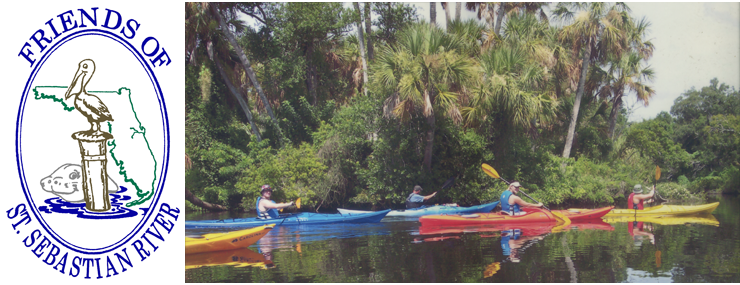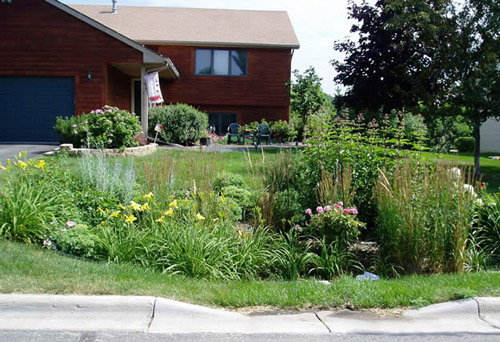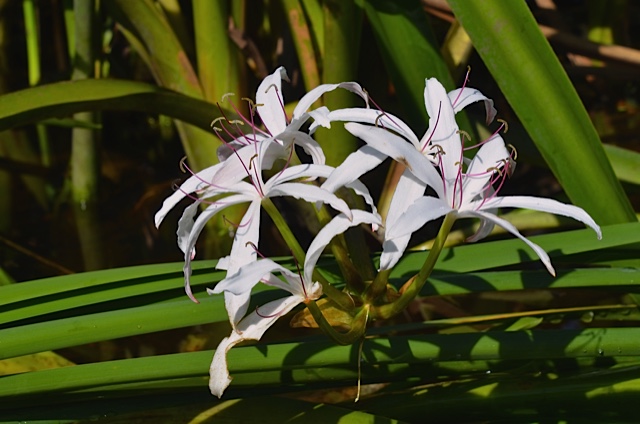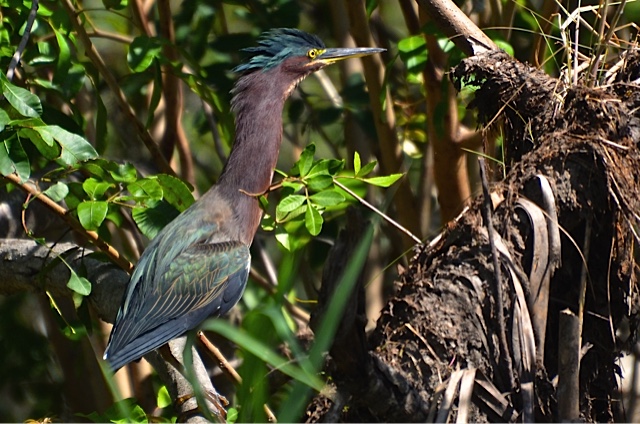
November 2017
www.fssr.org
Our newsletters are available in the "Library" section of our website, in PDF format, at
www.fssr.org/library.htm.
Please visit this page for more information about delivery options.
Rain Gardens with Robin Pelensky
Landscape architect Robin Pelensky is an advocate of using native plants in our landscaping. She will join us for a presentation on “rain gardens” at our meeting this month.
What is a rain garden? A rain garden can be created in a low-lying area of your yard, where rainwater tends to collect after a storm. Elevation changes in Florida are subtle and with its porous soils, habitats (and therefore plant adaptability) can vary dramatically with only slight changes in elevation. Join us to learn more about rain gardens and how they can help with those tough to maintain low areas of your yard, and the benefits to the surrounding environment they can provide.
The meeting is Tuesday, November 28th, 6pm at the North Indian River County Library, 1001 Sebastian Blvd. in Sebastian and all are welcome to attend. Please note the change in the start time of our meeting! This change is due to new policies for use of the library facilities. For more information, visit our website at www.fssr.org or call 772-202-0501.

Membership Renewal Reminder
October was our membership renewal month. All our memberships run from October through September each year, and are pro-rated, depending on when you first joined. We apologize for the late reminder to those for whom we do not have a working e-mail address, as we did not publish a newsletter in September, due to circumstances with hurricane Irma, etc.
The date following your last name on the mailing label of our newsletter is the month/year in which our records reflect that your membership either did or will expire. For more information on membership, please see the membership application on the back of this newsletter, or visit our website. You may also renew your membership online using a credit or debit card, via our website.
You are receiving this newsletter as a benefit of membership, but did you know that it is also available in digital format? Current members may opt to only receive the electronic/e-mail version of our newsletter, which adds to your support, and saves us time, money, and paper, although we use only 100% post-consumer recycled paper. Our newsletters are also available on the “Library/Newsletters” page of our website.
Additional benefits of our online newsletter are that you receive it earlier than the mailed copy, web addresses are “active” links and can be clicked on, and you can zoom in to make for easier reading. Be sure and check it out and let us know if you would like to receive the e-mail version of our newsletter instead. And thanks for your continued support!

Yard Sale – February 2018
We will be holding our annual yard sale again this year at 8am on Saturday, February 10th. This is one of our largest fund-raising events of the year and we are asking for your assistance in making it a success once again. If you would like to help in any way, we would appreciate your donations, or just stopping by the day of the sale to find that perfect something you can’t live without!
The sale will be held at the About Storage facility across from Dale Wimbrow Park on Roseland Road. The folks at About Storage have been most generous in donating the use of a storage unit the week of our sale, to collect and organize donations prior to the sale. We would ask that you collect and store items prior to the availability of a storage unit. If you have something that you just can’t wait to get rid of, or need assistance in moving, please contact us (see the front page of this newsletter). If you would like to help with organizing donations, pricing, or selling the day of, please let us know.
New Study Shows Americans’ Deep Appreciation of Nature
Contact with nature is an important part of growing up and linking Americans to one another....
The findings from an unprecedented national study of Americans’ relationship to nature reveal an alarming disconnection, but also widespread opportunities for reconnecting. The results are prompting nature conservation, environmental education and outdoor recreation leaders to rethink how they work to connect people with nature.
Americans face competing priorities for their time, attention and money. They live in places that often have more concrete than green space. It is increasingly normal to spend little time outside.
Americans of all backgrounds recognize that nature helps them grow healthy, be happy, and enjoy family and friends. Adults and children enjoy their time in nature. They feel affection for nature, are attracted to its beauty, appreciate its resources, and value its role in intellectual and spiritual development.
“The Nature of Americans National Report” details recommendations for restoring Americans’ connection to nature. The core premise of its recommendations is that connection to nature is not a dispensable amenity but, rather, is essential to the health, economic prosperity, quality of life and social well-being of all Americans.
The Nature of Americans is led by DJ Case & Associates. It builds on the late Dr. Stephen R. Kellert’s research on the importance of contact with nature to human well-being. This unique public–private collaborative is sponsored by the Fish & Wildlife Foundation of Florida, the Florida Fish and Wildlife Conservation Commission, Texas Parks & Wildlife Department, U.S. Fish and Wildlife Service, Disney Conservation Fund, Morrison Family Foundation, Wildlife Management Institute and Yale University.
More information and reports are available at www.NatureofAmericans.org.
source: Press Release, April 26, 2017, Florida Fish and Wildlife Conservation Commission
Water For Life – It's Time To Manage Water Like The Precious Resource It Is
“...no resource on Earth is as valuable as fresh water. Indeed, how a country manages its water can tell you a lot about the state of its economy and political stability. A study by Upmanu Lall and Casey Brown of Columbia University has shown that the prosperity of a country strongly correlates with how favorable its hydrology is. And a well-known World Bank model holds up Ethiopia as a stark example.”
“What is true for Ethiopia holds true for the rest of the world as well. No nation has managed to achieve prosperity without first delivering ‘water security’-without developing the infrastructure, institutions and practices needed to manage droughts and floods and to ensure a consistent water supply.”
source: “Water for Life,” Giulio Boccaletti, Nature Conservancy, Summer 2017
Cyanobacteria Monitoring Collaborative
Blue-green bacterium, commonly known as cyanobacteria, are getting lots of attention these days, and for good reason! As one of the first organisms on the planet, making their debut approximately 3.5 billion years ago, they are found virtually everywhere on the planet-in freshwater, lakes, polar ice caps, thermal hot springs, and even arid desert environments. Oxygen is produced as a byproduct of their unique photosynthetic processes, and they are thought to be the main reason that we have a breathable atmosphere today.
The downside to cyanobacteria, however, is that they are becoming especially abundant – and consequently problematic – in some freshwater systems. When conditions are right, these bacteria can divide several times a day, causing “blooms,” with larger forms developing thick surface scums that can be, at the least, aesthetically unpleasing and odorous, and, at worst, toxic to human and ecological health. “...effects on human health range from relatively benign skin rashes through reactions that look like second-degree burns, to potent neurologic and liver toxins. They are now commonly referred to as “Harmful Cyanobacteria Blooms” – HCBs for short.
A great deal of research is being done to understand when and why these elusive toxins are expressed, because they are not always present when there are bloom conditions. Despite all the work, state and federal agencies responsible for overseeing water quality… are severely limited in their resources to track when and where and why these bloom events are taking place. Many more “eyes on the water” are needed to determine when and where blooms occur. In an effort to connect current research and monitoring methods, coordinate efforts across jurisdictional boundaries, and fill-in important gaps in critical information, a collaborative working group of state environmental water quality and beach monitoring programs, departments of public health, tribes, nonprofit organizations, citizen monitoring groups, and academics, “The Cyanobacteria Monitoring Collaborative,” was formed.
The Collaborative invites anyone with an interest in learning more and those interested in contributing to the developing body of science to participate. To learn more, visit www.cyanos.org. If anyone does join to participate in this effort, please let us know! We would be glad to contribute assistance where we can.

Planting for Birds
If you plant it, the birds will come. Such is the growing mantra among ecologists, environmentalists, and now, the birding masses as well. But is it true? The short answer is yes. Native plants give birds the resources they need during migration, over frigid winters, and through nesting season. Did you know that 96 percent of land birds feed insects and spiders to their chicks? A single nest of chickadee babies may scarf down as many as 9,000 caterpillars before fledging. Native oak trees host the caterpillars of more the 557 types of butterflies and moths. Non-native Ginko tree? Only five. Plus, sharing your home with birds can make you a better birder. You get a front-row seat to their interactions and life cycle, which in turn will boost your understanding and experiences in the field. So get started – visit www.audubon.org/plantsforbirds where you will find lists of native plants appropriate to the region where you live, as well as a list of bird-friendly plants.
source: “Audubon,” Spring 2017
Calendar of Events
Tuesday, November 28, 6pm
Rain Gardens
Robin Pelensky, Landscape Architect
FSSR
North IRC Library
1001 Sebastian Blvd., Sebastian
info: www.fssr.org or 772-202-0501
December 2-3, 2017
Green America's "Green Festival Expo"
Broward Convention Center, Ft. Lauderdale
info: https://greenfestivals.com/ft-lauderdale-2017-dec-2-3.html
December 12, 2017, 12pm
Right Whale Monitoring/Migration
Julie Albert, MRC
Marine Resources Council/IRL Lagoon House
3275 NE Hwy US 1, Palm Bay
info: www.mrcirl.org or 321-725-7775
December 13, 2017, 4pm
The Role of Oceanic Eddies and Fronts in Removing Organic Carbon From the Surface Ocean
Melissa Omand, University of Rhode Island Graduate School of Oceanography
Harbor Branch Oceanographic Institute
5600 US 1 North, Ft. Pierce
info: www.fau.edu/hboi/community/events.php
Welcome New Members
David & Margaret Case
Wendy Oliver & Mike Brooks
Corporate Sponsors
About Storage
Roseland Community Association
Sedor Quality Consulting, Inc.
Tropical Kayak Tours
2017 Officers & Directors
Tim Glover, President
Buzz Herrmann, Vice President
Mark Bondy, Secretary
Bill Brennan, Treasurer
Tom Bauer, Director
Lee Ann Kluepfel, Director
Judy Orr, Director
Jane Schnee, Director
Bob Stephen, Director
Lynn Stieglitz, Director
Bruce Zingman, Director
The Friends of St. Sebastian River newsletter is published bi-monthly, five times per year, starting in January, except July. A subscription is included with membership. Delivery by email is a benefit of membership, and encouraged, as it saves time, money and paper, and increases your support! If you would prefer to receive our newsletter by email only, please email us at info@fssr.org. Please contact us to notify of change of address or email, as well.
The Friends of St. Sebastian River is a 501(c)(3) non-profit organization and donations are tax-deductible to the extent allowed by law.
For membership information, visit www.fssr.org
Banner photo courtesy of Kristen Hanson
Friends of St. Sebastian River
P.O. Box 284
Roseland, FL 32957-0284